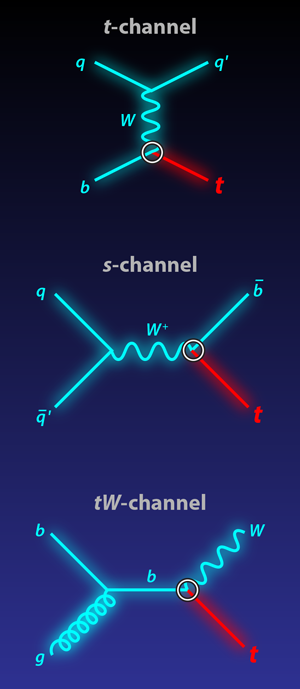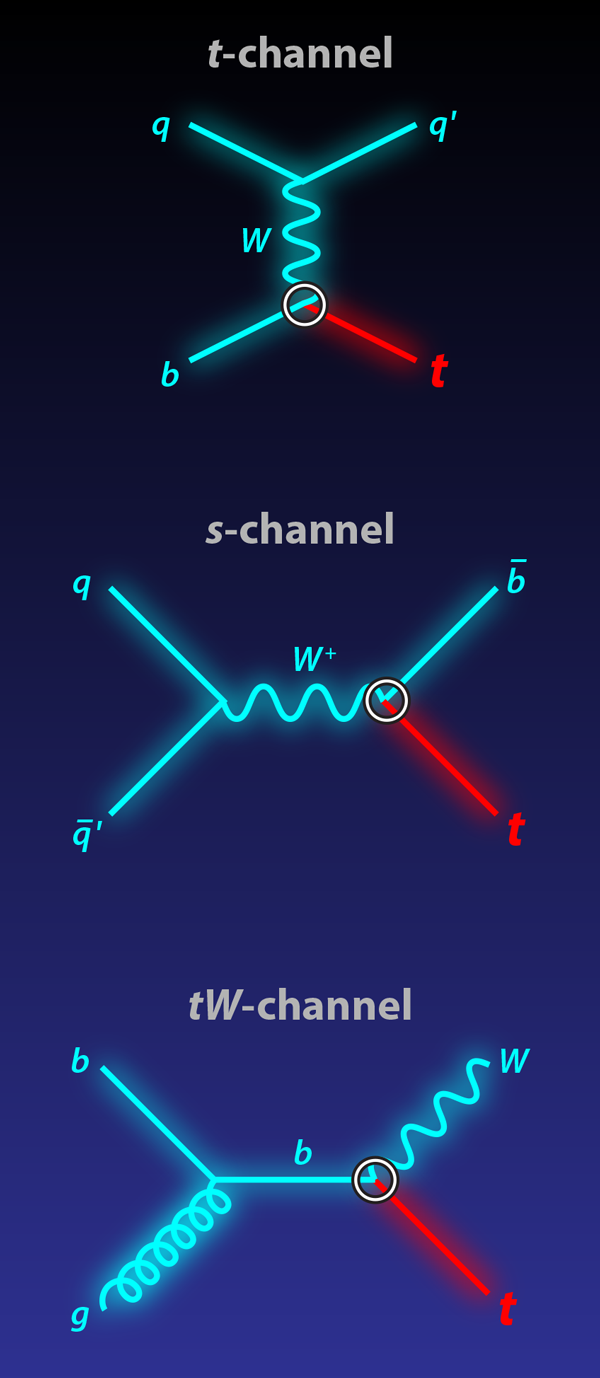Top Quarks Go Solo in Rare Events
The subatomic elementary particles known as quarks are among the building blocks of the standard model (SM) of particle physics. Protons and neutrons are made of the lightest, up and down quarks, but the unstable strange, charm, bottom, and top quarks can also be produced in high-energy particle accelerators. The enigmatic top quark—which is the heaviest elementary particle, weighing as much as a gold nucleus—has only been studied at Fermilab’s Tevatron collider near Chicago and at the Large Hadron Collider at CERN, Geneva. It is most often produced with its antiparticle (antitop) through the strong interaction, but it also appears singly through the electroweak interaction, as was demonstrated in [1,2]. Two new papers in Physical Review Letters [3,4] report the first observations of single top quarks coming out of less common electroweak reactions, or “channels.” The results fall within SM predictions, but further studies of the relative frequency of these rare channels may reveal new physics, such as a hidden generation of quarks or unexpected top-quark couplings.
Although it fits into the SM as the partner of the bottom quark, the top quark appears anomalous because of its extremely large mass of giga-electron-volts ( ), about times that of the bottom quark. Its mass is also close to those of the and bosons, the force carriers of the electroweak interaction, and that of the recently discovered Higgs boson, leading to speculation that the top quark may play some role in triggering electroweak symmetry breaking, which confers mass on otherwise massless particles.
One of the ways to study the top quark is to look at how it appears in particle collision debris. Theory predicts that electroweak interactions will produce top quarks in three distinct channels (see Fig. 1). The most common channel—and the only one previously isolated—is the channel, in which a bottom quark transforms into a top quark through the exchange of a boson with another quark. In the rarer channel, a quark and antiquark convert—through an intermediate boson—into a top and an antibottom. The last single-top process is the channel, given this name because it produces a top and boson from the interaction of a bottom quark and gluon.
The rate of occurrence for these different channels is governed by elements of the Cabibbo-Kobayashi-Maskawa (CKM) matrix, which connects the electroweak interactions of all the quarks [5,6]. In the standard model, this is a matrix, with one row and column for each of the three doublets, or generations, of quarks. As can be seen in Fig. 1, all of the single-top channels include an interaction between a top quark, a bottom quark, and a boson. The strength of this interaction, or vertex, is given by the CKM matrix element . Current estimates—based on a global fit of all the available data within the SM framework—suggest . However, this assumes that the CKM matrix is complete; i.e., there are no other quarks. A fourth, as-yet-undiscovered generation of quarks would enlarge the CKM matrix and likely affect the value of . Observations of single top quarks can provide direct measurements of and thereby test for additional structure in the CKM matrix, or give evidence for other unexpected processes involving top quarks [7].
Single-top production is a very rare process, happening at the Tevatron about once in every proton-antiproton collisions at tera-electron-volts ( ). When the top quark is produced, it immediately decays into a bottom quark and a boson. About of the time, the decays to a high-energy electron or muon and a neutrino. The electron or muon gives a striking signature in the detector, but the neutrino escapes from the apparatus undetected and gives rise to an apparent imbalance in the total momentum transverse to the direction of the colliding beams. The bottom quark gives rise to a collimated spray or “jet” of particles in the detector, including a long-lived particle (a hadron) that typically decays a few millimeters from the initial collision point. Thanks to silicon detectors placed a few centimeters from the beam line, these “ jets” can be identified or “tagged,” distinguishing them from other, more common jets produced in the decays of light quarks and gluons. Previous work at the Tevatron was able to isolate the -channel process in their top-quark event sample [1,2]. And although the Tevatron is no longer running, scientists from its CDF and D0 experiments have now combined some of their past data in order to look for the rarer channel.
Selecting events with high-energy electrons or muons, unbalanced transverse momentum, and -tagged jets allowed the physicists of the CDF and D0 collaborations to narrow down their -channel search to a few 10,000s of events. But over of these top-producing events result from either strong interactions that give two top quarks or the already well-known -channel single-top process. No single event property provides enough discrimination power to clearly distinguish -channel single top from these backgrounds, so the collaborations employed boosted decision trees (BDT), a multivariate analysis technique based on machine learning methods to extract the most from the available information in each event. This technique relies on Monte Carlo computer simulation of high-energy particle collisions and the associated detector response to test how well certain combinations of variables—like the total energy in the event and the angles of different jets—can identify the signal from the major background sources. These simulations were extensively checked using data control samples, and their quality is a testament to the work of the many theoretical and phenomenological groups involved in modeling physics at these energies. Using a BDT analysis, each collaboration was able to demonstrate evidence for -channel single-top production [8], but only by combining their datasets did they manage to have enough sensitivity to reach the “five sigma” observation threshold, which is the gold standard in high-energy physics for establishing new phenomena beyond any reasonable doubt. The resulting rate or cross-section measurement of picobarns (pb) [3] is in good agreement with the latest theoretical calculation within the SM framework of [9].
The -channel process is initiated by the interaction of a quark and an antiquark. Since the LHC collides protons with protons (not antiprotons), it doesn’t have the same high-momentum antiquarks as the Tevatron and therefore is less likely to observe the channel. However, the much higher collision energy of the LHC ( in 2012) gives it a decisive advantage for the channel process. When the boson decays to an electron or muon, this process gives rise to events with two high-energy electrons or muons, momentum imbalance, and a jet, which unfortunately is nearly the same signature as the pair production of top quarks. Employing similar BDT-based analysis techniques, the CMS collaboration extracted a strong enough signal from part of the collision dataset recorded in 2012 to report observation of the process. The corresponding cross-section measurement is [4], in agreement with the SM theoretical prediction of [10], and giving a lower bound of at the confidence level. The ATLAS collaboration at the LHC has also reported evidence for production, but so far at a lower significance level [11].
Each of these analyses represents an experimental tour de force, extracting a very small signal from an almost overwhelming background. The Tevatron experiments developed multivariate analysis techniques, over many years, using them in their earlier -channel single-top-quark observation [1,2] and also in their searches for the Higgs boson. From the start of data taking, the LHC collaborations adopted similar techniques, which are already bearing fruit with the observation. With the closure of the Tevatron accelerator in 2011, the baton has now passed to the LHC, where we are looking forward to the first results from the upcoming run starting in 2015. This should allow a rich program of single-top-quark studies, subjecting the SM predictions to more detailed scrutiny and perhaps allowing a first glimpse of even rarer processes, such as the simultaneous production of a top quark and a or Higgs boson. Much challenging analysis will be needed, but these studies are sure to shed more light on this most mysterious elementary particle.
References
- V. M. Abazov et al. (D0 Collaboration), “Observation of Single Top-Quark Production”, Phys. Rev. Lett. 103, 092001 (2009)
- T. Aaltonen et al. (CDF Collaboration), “Observation of Electroweak Single Top-Quark Production,” Phys. Rev. Lett 103, 092002 (2009)
- T. Aaltonen et al. (CDF Collaboration)†), “Observation of -Channel Production of Single Top Quarks at the Tevatron,” Phys. Rev. Lett. 112, 231803 (2014)
- S. Chatrchyan et al. (CMS Collaboration), “Observation of the Associated Production of a Single Top Quark -and a Boson in Collisions at ,” Phys. Rev. Lett. 112, 231802 (2014)
- N. Cabibbo, “Unitary Symmetry and Leptonic Decays,” Phys. Rev. Lett. 10, 531 (1963)
- M. Kobayashi and T. Maskawa, “-Violation in the Renormalizable Theory of Weak Interaction,” Prog. Theor. Phys. 49, 652 (1973)
- For a review, see T.M.P. Tait, and C.-P. Yuan, “Single Top Quark Production as a Window to Physics Beyond the Standard Model,” Phys. Rev. D 63, 014018 (2000)
- T. Aaltonen et al. (CDF Collaboration), “Evidence for s-channel Single-Top-Quark Production in Events with One Charged Lepton and Two Jets at CDF,” Phys. Rev. Lett. (to be published); arXiv:1402.0484; T. Aaltonen et al. (CDF Collaboration), “Search for -channel Single Top Quark Production in the Missing Energy Plus Jets Sample using the Full CDF II Data Set,” arXiv:1402.3756; V. M. Abazov et al. (D0 Collaboration), “Evidence for -channel Single Top Quark Production in collisions at TeV,” Phy. Lett. B 726, 656 (2013)
- N. Kidonakis, “Next-to-Next-to-Leading Logarithm Resummation for -channel Single Top Quark Production,” Phys. Rev. D 81, 054028 (2010)
- N. Kidonakis, “NNLL Threshold Resummation for Top-Pair and Single-Top Production,” arXiv:1210.7813
- G. Aad et al. (ATLAS Collaboration), “Evidence for the Associated Production of a boson and a top quark in ATLAS at TeV,” Phys. Lett. B 716, 142 (2012)





